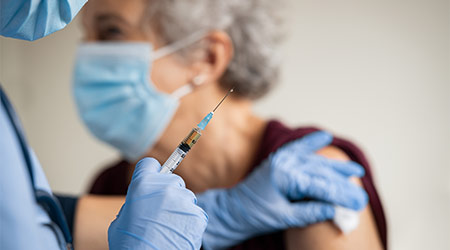As COVID-19 vaccine trials progressed and were ultimately approved, healthcare facility service providers and emergency management (EM) teams were able to put together step-by-step plans on what a COVID vaccination plan would look like.
Now, with a vaccine available, in order to successfully distribute it in a timely and efficient manner, vaccine distribution plans should feature the following checklists:
- Messaging: Control the conversation by utilizing a single, expert source (such as the CDC or WHO) to guide your messaging to patients about the safety and security of receiving a vaccine.
- Retrieval: Know the date/time the vaccine is to be received, number of doses, how often it will be received throughout the month, and identify the authorized deliverer.
- Storage: Develop and maintain ultra-cold storage for the vaccines. The Pfizer vaccine needs to be kept at minus 70 degrees Celsius — colder than the winter in Antarctica. This type of storage is typical in research hospitals and labs, but often not available in suburban hospitals or independent pharmacies. Many healthcare facilities will need to procure special storage to keep the virus cold enough to be viable.
- Accessories: Wipes, alcohol, gloves, hand sanitizer, proper PPE, vaccine record cards, biological waste disposal containers and more that will be required to administer the virus.
- Government involvement: With the new administration’s 100 million vaccinations in 100 days initiative, healthcare facilities need to maintain relationships at the national level and be attune to sudden changes in federal mandates.
- Vaccine reactions: It’s possible that someone may have a reaction to the vaccine, and the clinic must be prepared to tackle any related issues. Require medical personnel to wait in a waiting room with patients who have recently received the vaccine to provide help if needed.
Executing a high distribution of the vaccine is possible with a solid plan and finalized process in place, built upon the foundation of a strong emergency management and safety program. With a structure in place, frontline workers are able to focus on the influx of patients while the operation center can focus on logistics, compliance and guidance.
As this new year continues, even with the newest variant of the virus, we hope to see vaccines and immunity increase while the number of COVID deaths, cases and the overall spread decreases. One year ago, only a few cases were in the United States. Today, COVID-19 has infected 24.6 million Americans and left more than 400,000 dead. This vaccine helps us to remember that there is a light at the end of the tunnel.
Stopping the spread can only work when we do it together. Distributing a vaccine can only work when we have a plan.
Scott Cormier is the Vice President of Emergency Management, Environment of Care (EOC) and Safety at Medxcel, specializing in facilities management, safety, environment of care, and emergency management and provides healthcare service support products and drives in-house capabilities, saving and efficiencies for healthcare organizations that, in turn, improve the overall healing environment for patients and staff. Cormier leads the development and implementation of emergency management, general safety and accident-prevention programs for a national network of hospitals that Medxcel serves.

 Hand, Foot and Mouth Disease on the Rise
Hand, Foot and Mouth Disease on the Rise Preparing for the Hazards of Winter Weather
Preparing for the Hazards of Winter Weather BayCare Reveals Pagidipati Children's Hospital at St. Joseph's
BayCare Reveals Pagidipati Children's Hospital at St. Joseph's Why Identity Governance Is Becoming a Facilities Management Issue
Why Identity Governance Is Becoming a Facilities Management Issue Habitat Health Opens South Los Angeles PACE Center
Habitat Health Opens South Los Angeles PACE Center